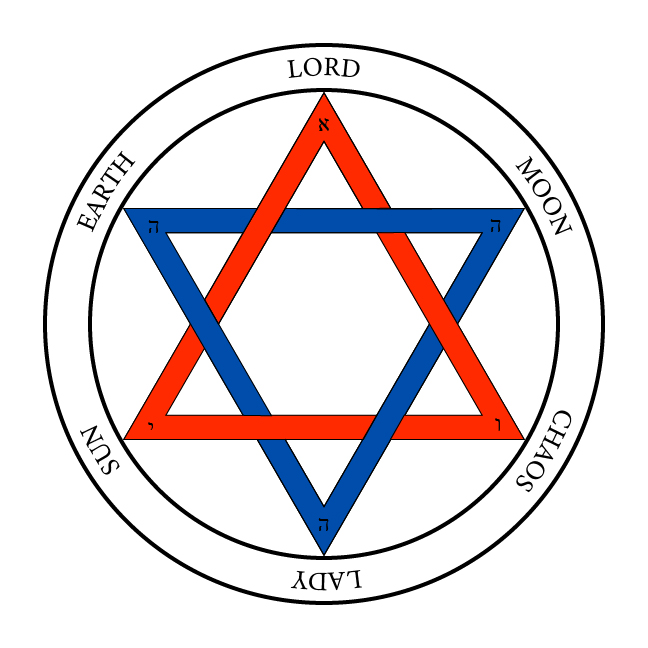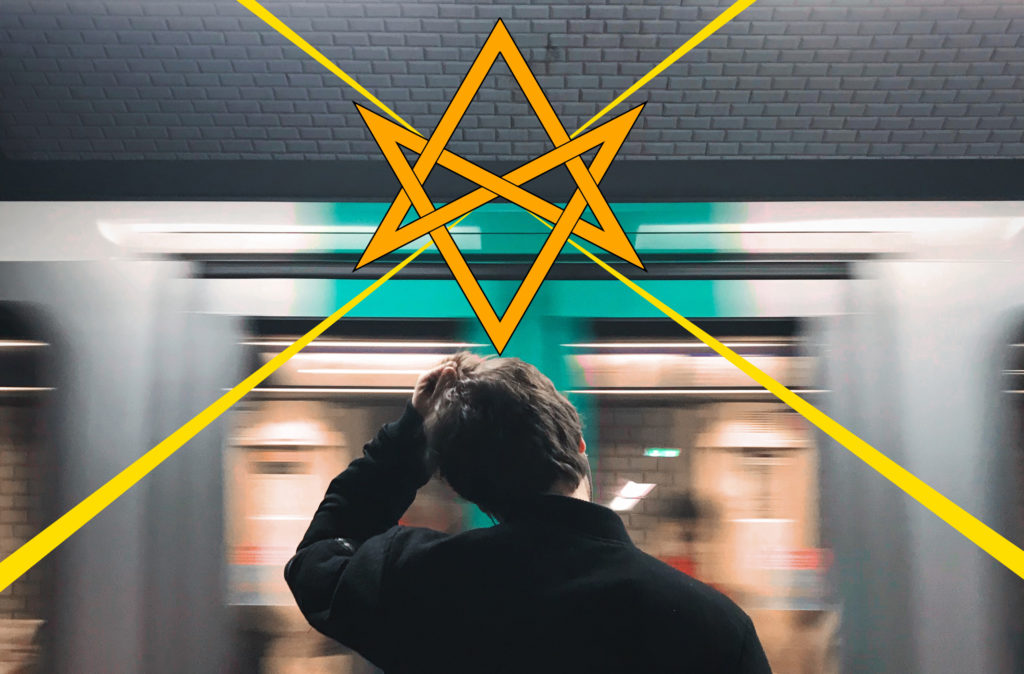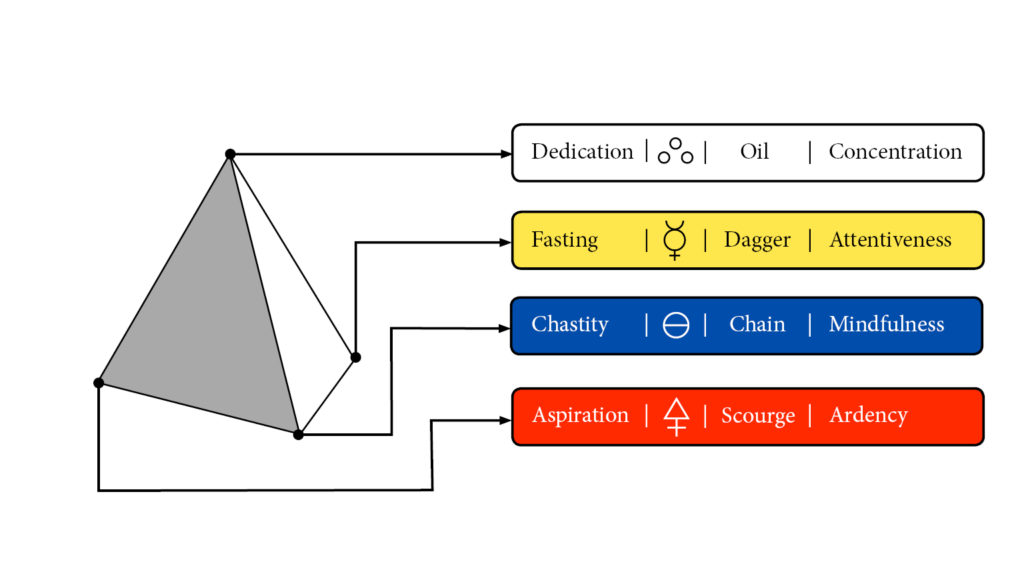Having covered the function of the three Lords in the Mass, I want to now cover the three feminine principles they’re the counterparts of.
The three feminine principles are most conspicuous in the Collects. There’s the Moon in the third Collect, the Lady in the fourth, and the Earth in the sixth.
Each feminine principle is the counterpart of a masculine principle. The Moon is the counterpart of the Sun, the Lady (ostensibly Nuit) is the counterpart of the Secret Lord (Hadit), and the Earth is the counterpart of Chaos (the sole viceregent of the Sun upon the Earth, i.e., the microcosmic counterpart of the macrocosmic Lord in the Universe).

If we assume each of the three feminine principles can be represented by each of the three mother letters of the Hebrew alphabet, then it stands to reason that the Lady (Nuit) is א, mercury, or air; the Earth is מ or salt; and the Moon is ש, sulphur, or blood.
The function of the three feminine principles—which are also the three alchemical principles—is evinced in part III of the Mass, “The Ceremony of the Introit.” In terms of the performance of the ritual, this is actually the first part. It starts when the Deacon admits the congregants and ends with the congregants saying “So mote it be” after the Priestess consecrates the lance and declares the Lord (Chaos) to be present among us.
As I showed in the previous article, the purpose of the Ceremony of the Introit is to invest the Priest with the powers of the three Lords (Hadit, the Sun, and Chaos). In particular, its most important function is to devote the will of the Priest—as represented by his lance—exclusively to the grail of the Priestess. This perfects his will and sets it on a course, the natural terminus of which is its annihilation in the Cup of Babalon. But this process of investing the Priest with these functions and devoting him to the divine feminine is carried out entirely by the Priestess herself, aided by the two Children.
After the recitation of the Creed, the Priestess enters, flanked by the two Children. The first Child enters with the ewer and the salt. Salt is מ which is also the feminine principle of Earth. Then the Priestess (here called the Virgin) enters with the sword and the paten. The sword is א, mercury, or air; the paten is a solar symbol. Then the second Child enters with the censer and perfume, indicating ש, sulphur, or fire/blood.
Facing the congregation and Deacon, the Priestess says, “Greeting of Earth and Heaven!” and all give the Hailing Sign of a Magician, which is a symbol of the sacrament of marriage. She is in a sense declaring the purpose of the ritual, which is the union of the microcosm (earth) with the macrocosm (heaven), which will be carried out by means of the formula of IAO.
The Priestess places the paten on the altar before the graal. She is not in possession of the graal at this time, since she is not performing the function of Babalon. Her first function is mercurial as indicated by the sword (א, alchemical mercury, or air) and the serpentine circumambulations. As has been pointed out, the three and a half circumambulations indicate her identity with kundalini and her power to raise the Priest to his spiritual vocation.
To understand the next part, you need to look at Magick, Part Two, chapter IV, “The Scourge, the Dagger, and the Chain.” That chapter shows that the three alchemical principles as embodied in the three magical weapons are used to prepare the magician for a magical operation. The scourge is ש, sulfur, or fire. It’s used against the body to invigorate the Nephesh, to keep one awake and ardent. The dagger is א, alchemical mercury, or air. It symbolizes alertness and is the ability of the magician to know when he is on task (concentrated) or not. Finally the chain is מ or salt. It represents fixity of attention or mindfulness of the task at hand.
The Lustral Water! Let thy flood
Liber Pyramidos
Cleanse me—lymph, marrow, & blood!
The Scourge, the Dagger & the Chain
Purge body, breast & brain!
The Fire Informing! Let the Oil
Balance, assain, assoil!
Having struck herself with the scourge, let her blood with the dagger, and having put the chain around her neck, the magician would then anoint herself with the Holy Oil (see Magick, Part Two, chapter V). This consecrates the magician to the Great Work.
All of this happens in its own way in the Ceremony of the Introit.
First the Priestess draws her sword and pulls down the veil of the tomb. This is the only part of the ritual where the Priestess uses the sword. She’s using it to free the Priest from his natural condition, as represented by his entombment. As Crowley says in De Lege Libellum, that “which men call life is but a shadow of that true Life, [their] birthright, and the gift of the Law of Thelema.” In other words what we call life is more like death. We “feel little; what is, is balanced by weak joys” (AL I.31). Thelema is a spiritual path which leads us to live perhaps for the first time, but it requires a passage through what appears to most people as a kind of death. This spiritual death—erotic destruction—is what is dramatized in the Mass at the opposite side of the room at the altar. So the tomb and the altar spiritually and spatially balance one another. (See Magick in Theory and Practice, ch VIII, on how objects in a ritual ought to balance one another.)
But the journey begins with discernment. You have to know that there is something else besides the ordinary life in order to pursue the extraordinary one. That is in essence what the Priestess is doing on behalf of the Priest here. She is cutting away the veil of darkness around him and calling him forth to a new spiritual vocation. And of course this being a cultic rite, not a personal journey, his vocation is actually to administer on behalf of a congregation, i.e., “the breathren”.
When he asks how he shall be worthy to take up this vocation, she proceeds to purify him with water and the salt and consecrate him with fire and incense.
As Crowley says in Magick in Theory and Practice, “Purity means singleness.” It means fixing the mind upon the one task which must be accomplished in the magical ceremony. It is represented by the weight of the chain around the neck, which we have already seen is connected with מ (which is also elemental water) or alchemical salt.
As already mentioned, the scourge invigorates the Nephesh or the animal soul. It raises energy or generates ardency for the task. When the Priestess says, “Be the PRIEST fervent of body and soul!” the fire and incense are serving the same function as the scourge.
Then she adorns the Priest with the two mantles. The robe represents his function as Priest of the Sun; the crown represents his function as Priest of the (Secret) Lord Hadit.
At this point we might expect her to anoint him with the Holy Oil, thus signifying his readiness to unite the higher in himself with the lower. That’s not what she does, though. Instead she kneels and strokes the lance eleven times, thereby consecrating it to the Lord Adored (Chaos).
What I take from this is that the natural will thus perfected—i.e., devoted exclusively to Nuit—just is the higher part of the individual now ready to do the work of union or sacred marriage.
In other words, it’s not quite correct that the sex instinct is the Holy Guardian Angel. The sex instinct properly oriented and devoted to heaven is the means by which union with the divine will occur. A will thus perfected must inevitably cross the Abyss, thus annihilating itself and becoming its feminine opposite in the Mother Babalon.
In other words, the Priestess—who is “actually Virgo Intacta or specially dedicated to the service of the Great Order”—has now made the Priest like her through the Ceremony of the Introit. She has made him “virgin” or “chaste” unto the Lord. His sex instinct or natural will is now devoted exclusively to the most high and has thus been perfected.
Having accomplished that, the Ceremony of the Introit ends, and the Ceremony of the Opening of the Veil commences. Now their roles change. The Priestess is no longer the primary agent in the ritual; the Priest is. Taking her by the hand, he raises her. He now refers to her as “Virgin pure without spot”. Her function is no longer alchemical mercury. She is now ה final of the formula Tetragrammaton. He is no longer a natural man but now functions as ו of Tetragrammaton. Thus he seats her upon the altar, which we know from its crimson altar cloth is representative of Binah or the Throne of the Mother. She now represents Babalon, and the rest of the ritual is about how he will go about pouring all he is into her cup, thereby undergoing destruction in erotic union with her.



